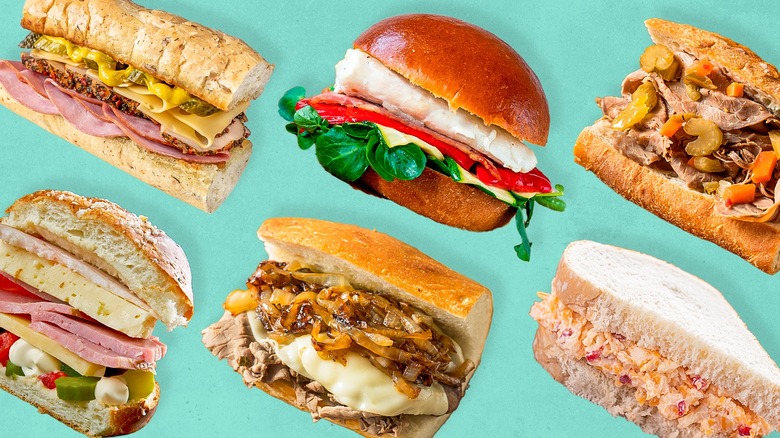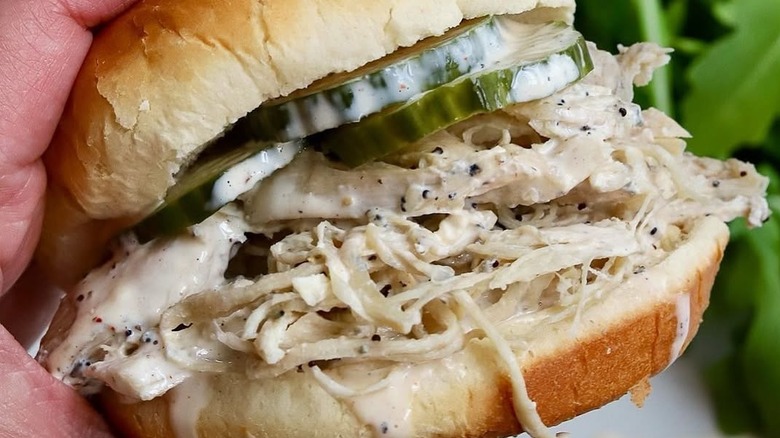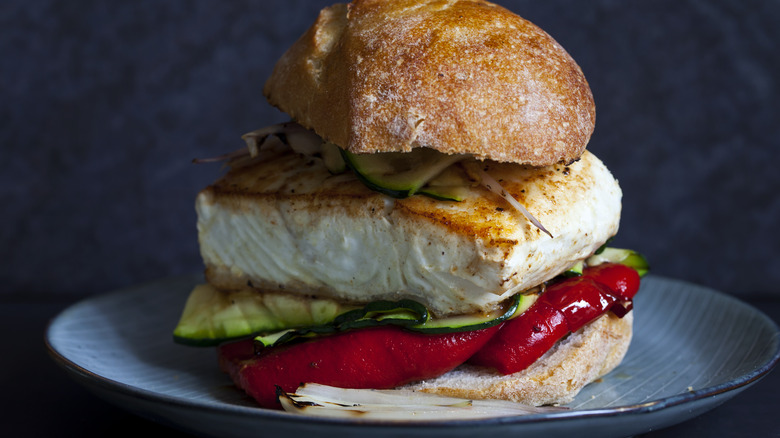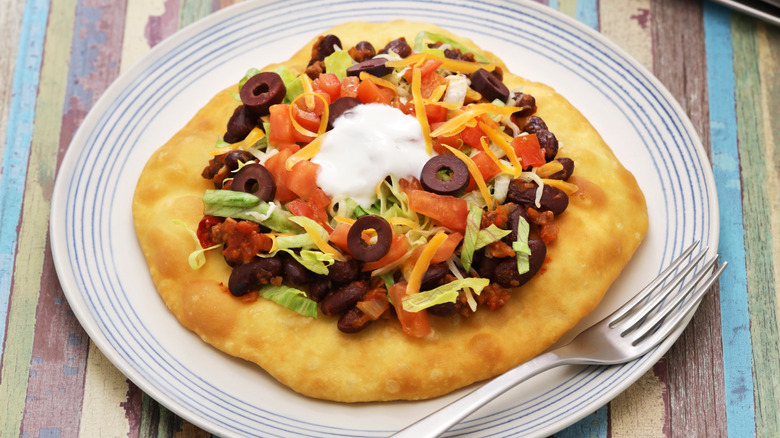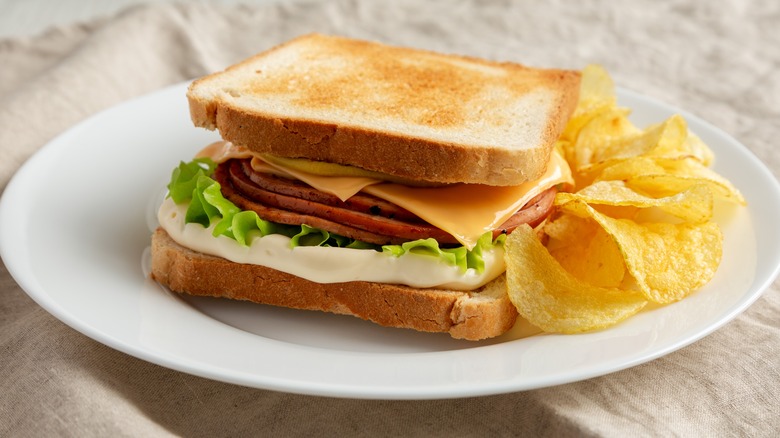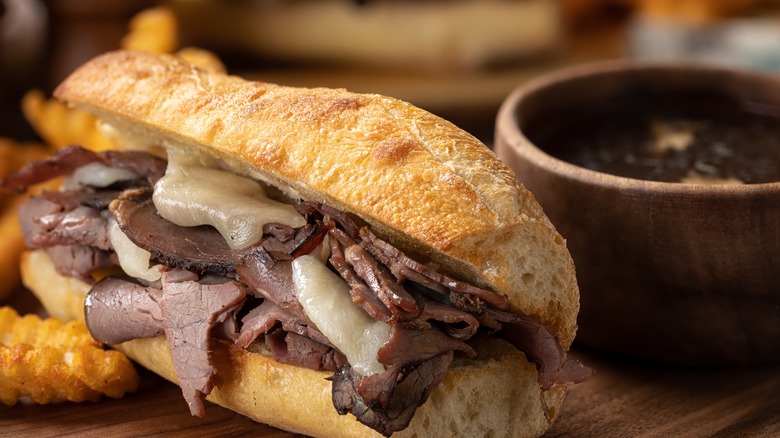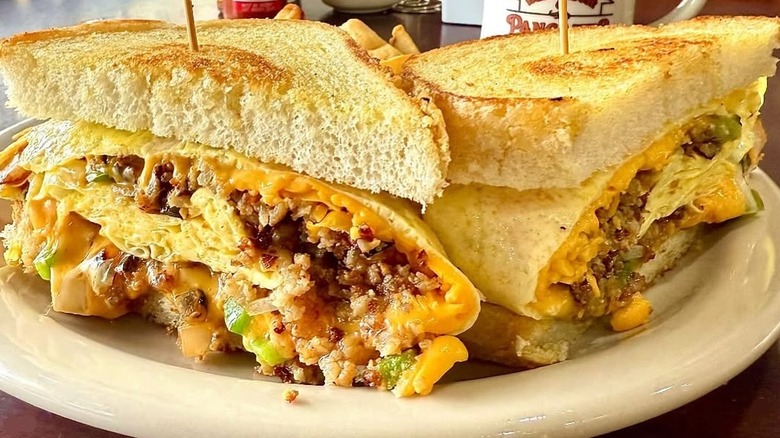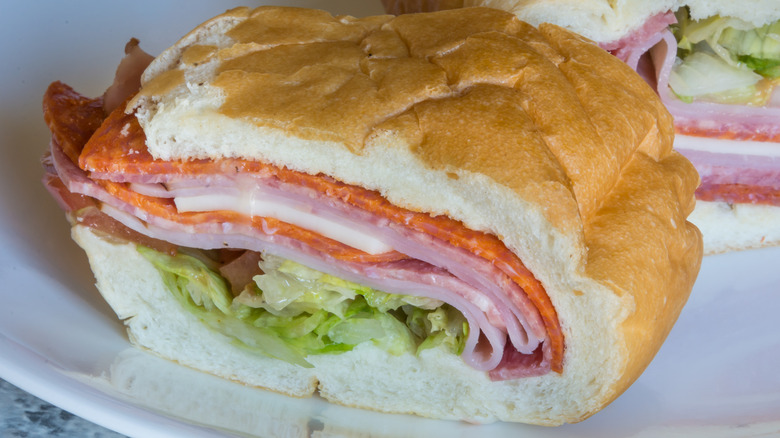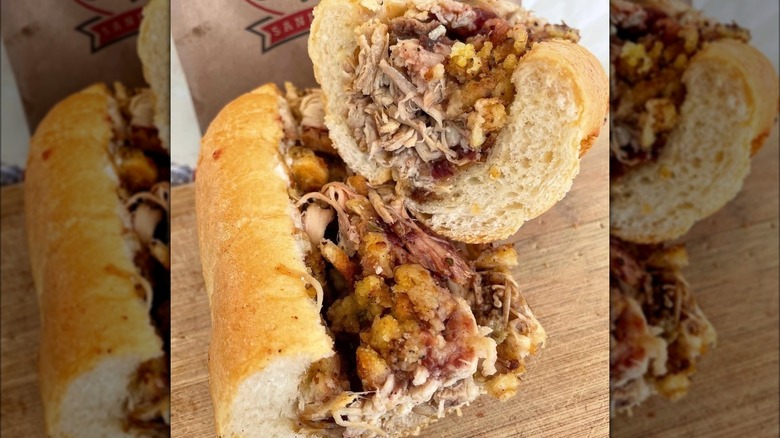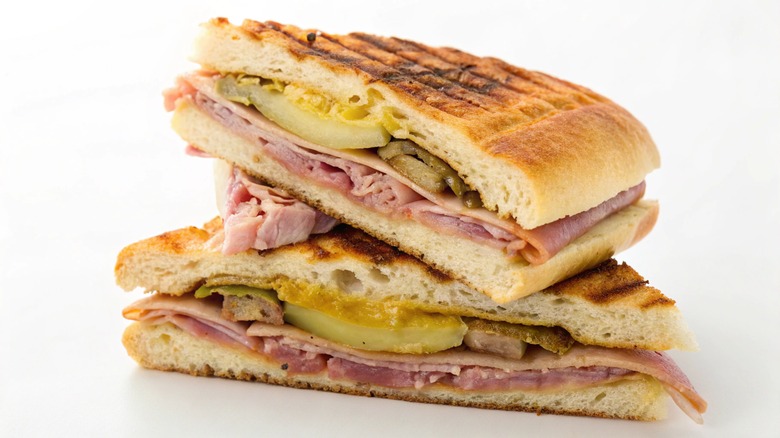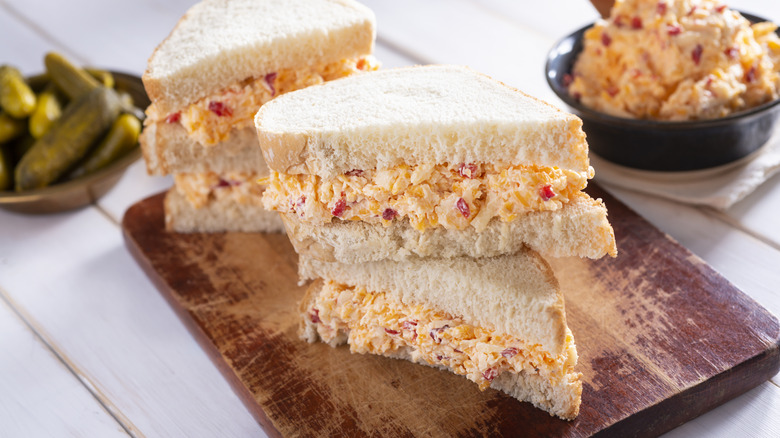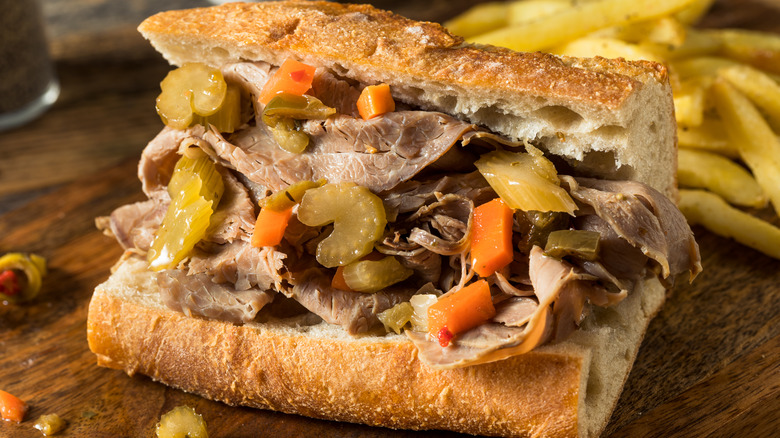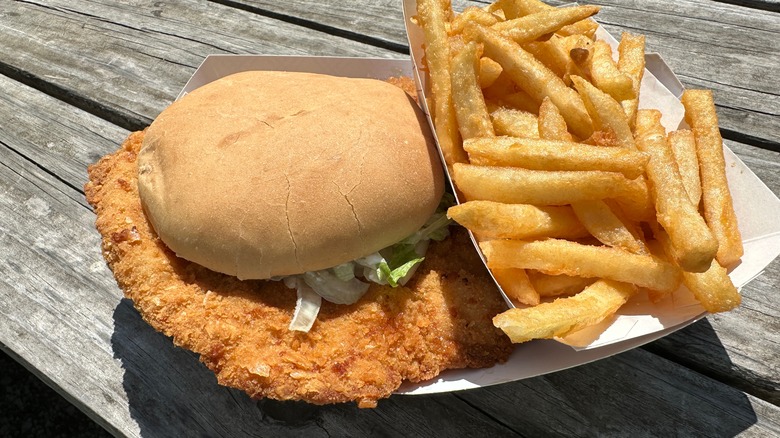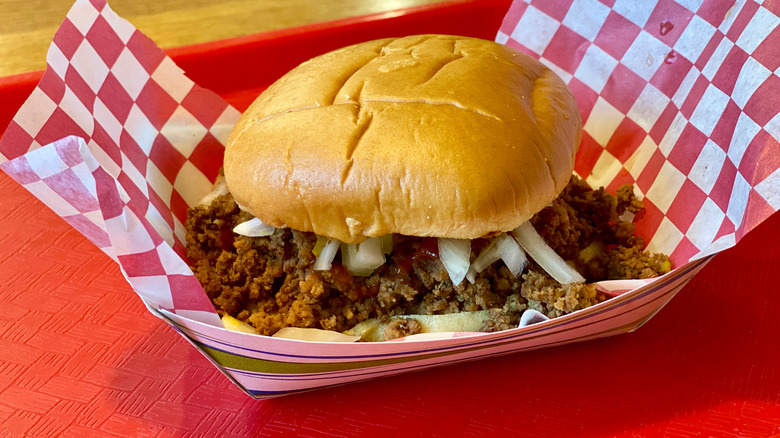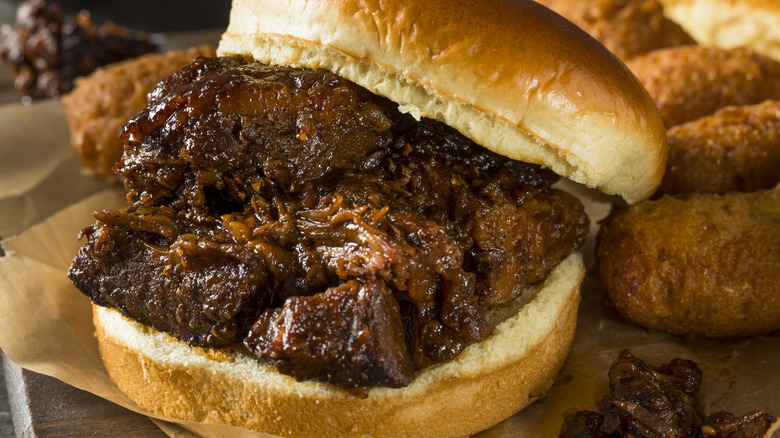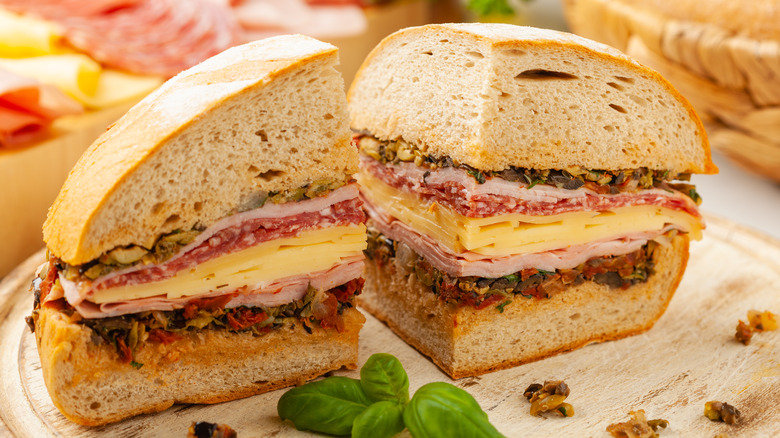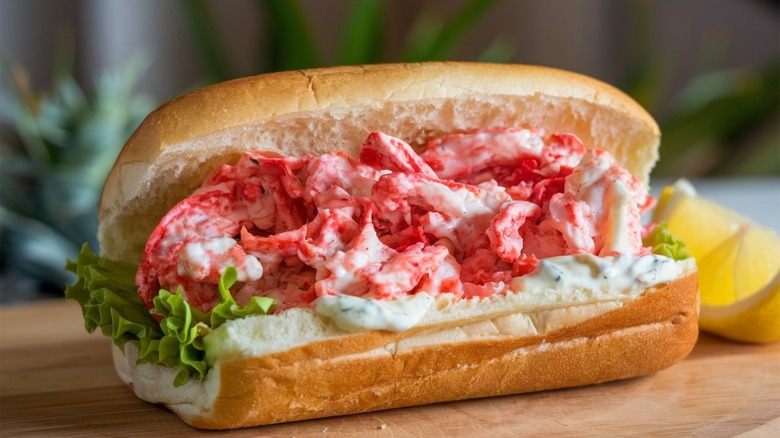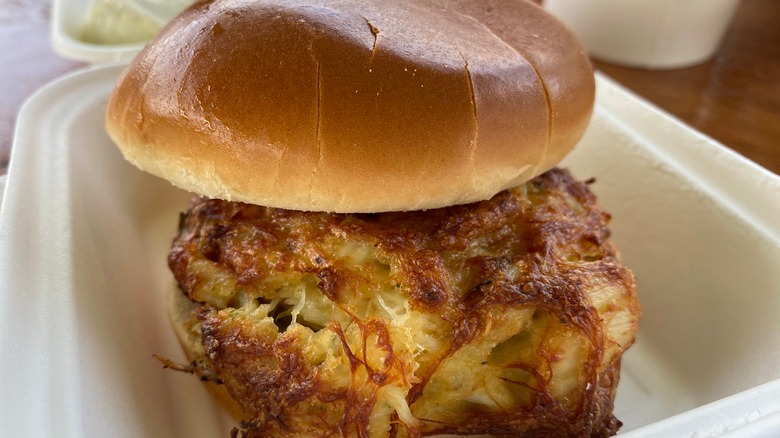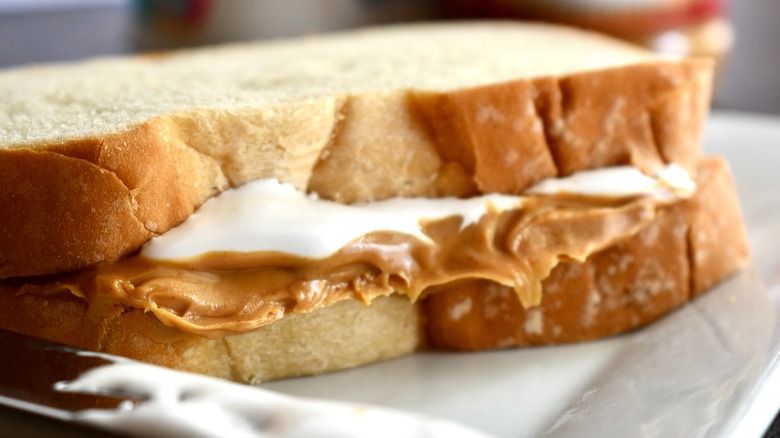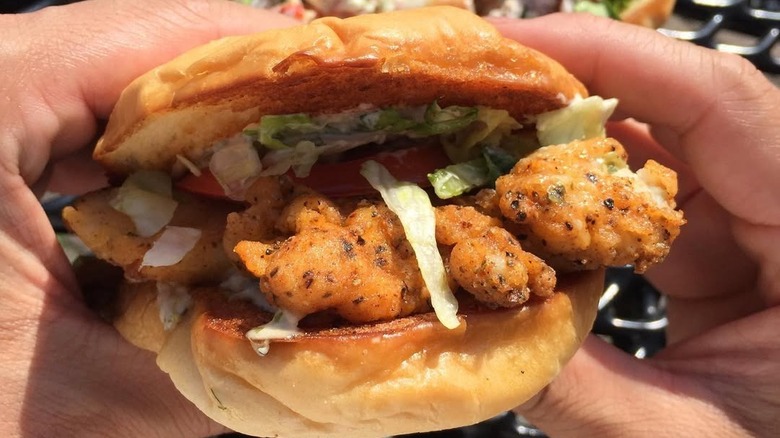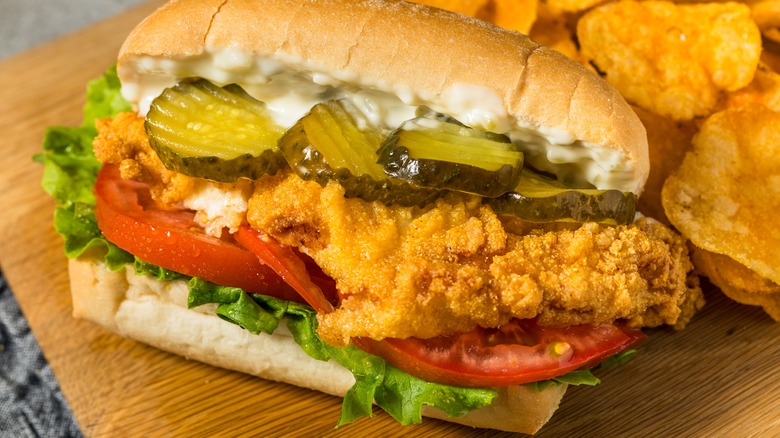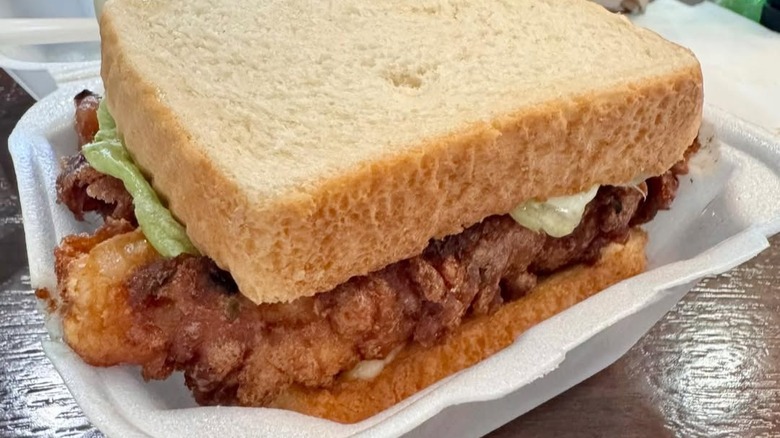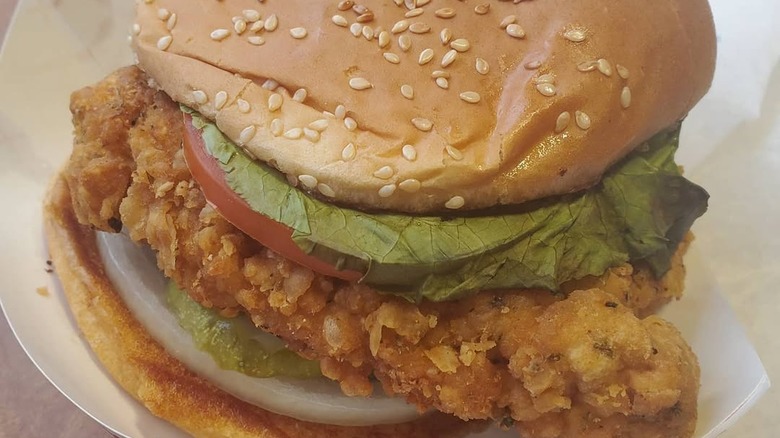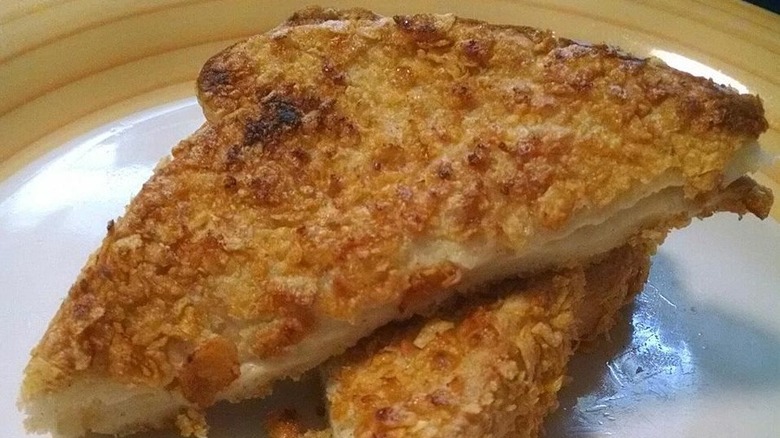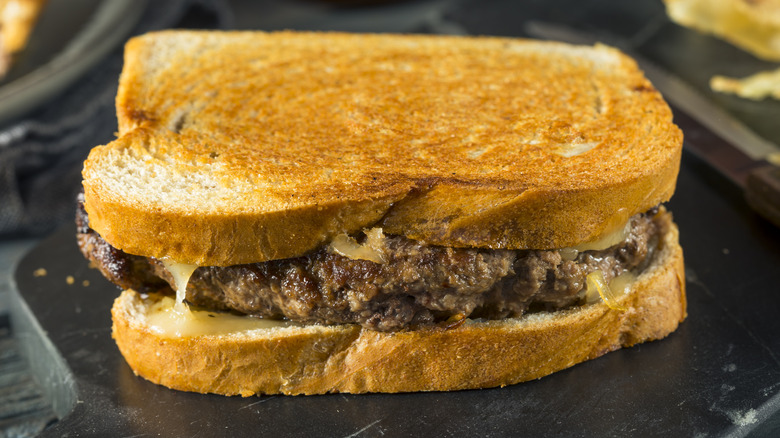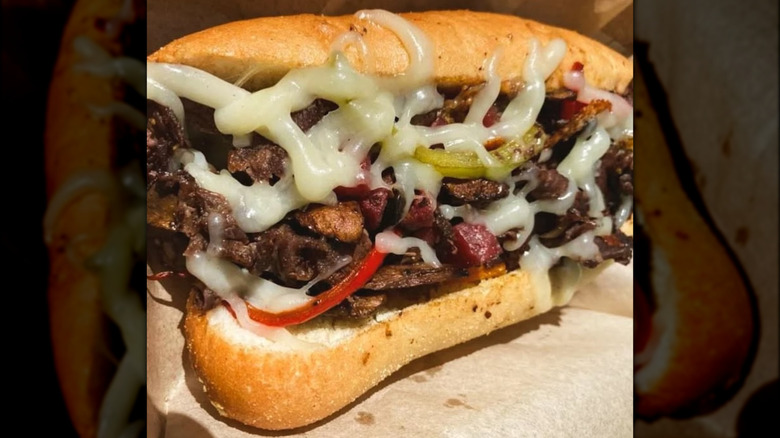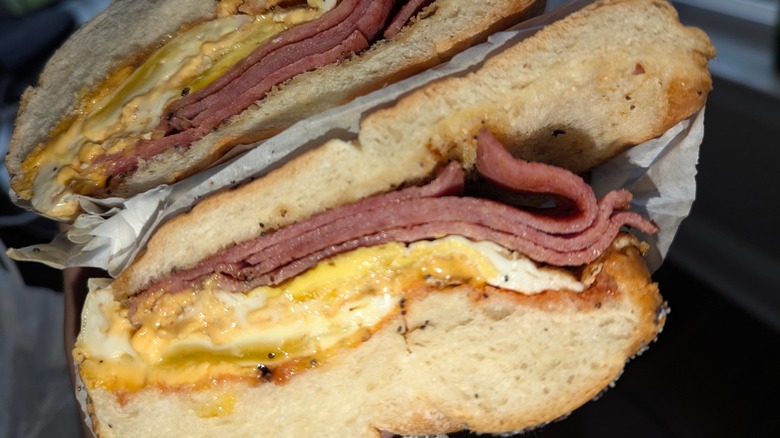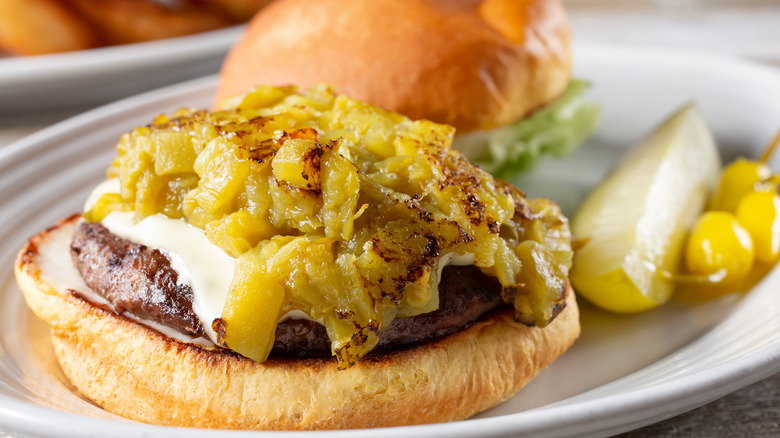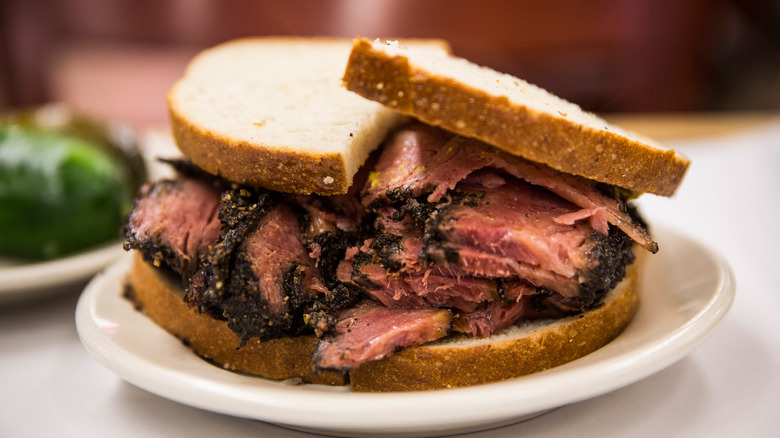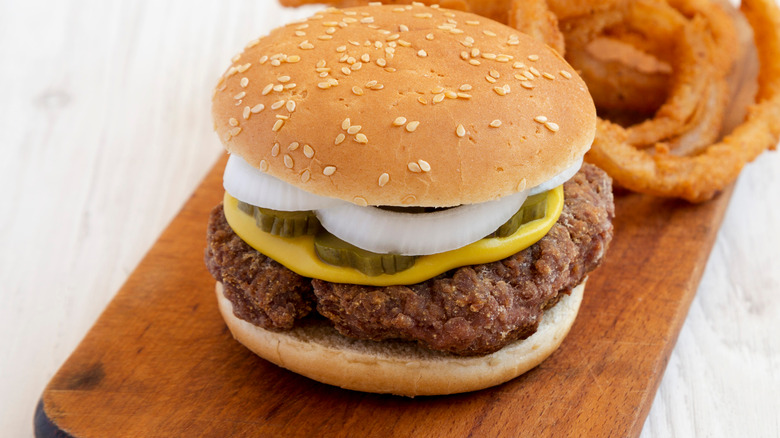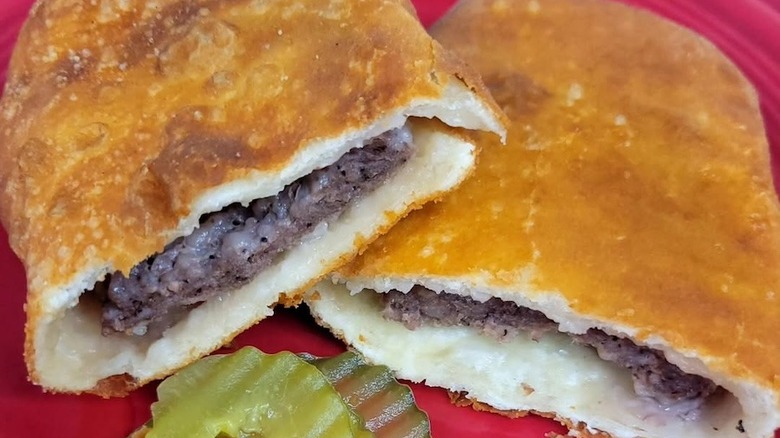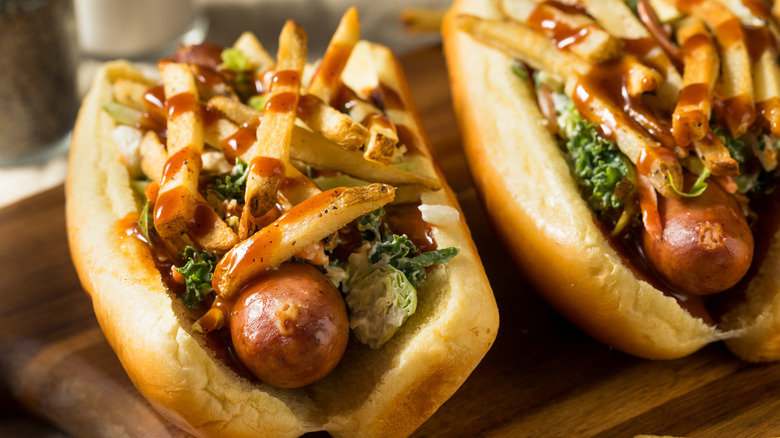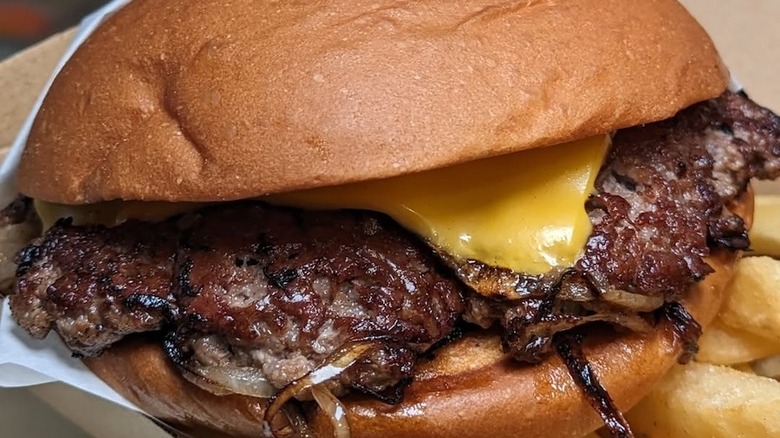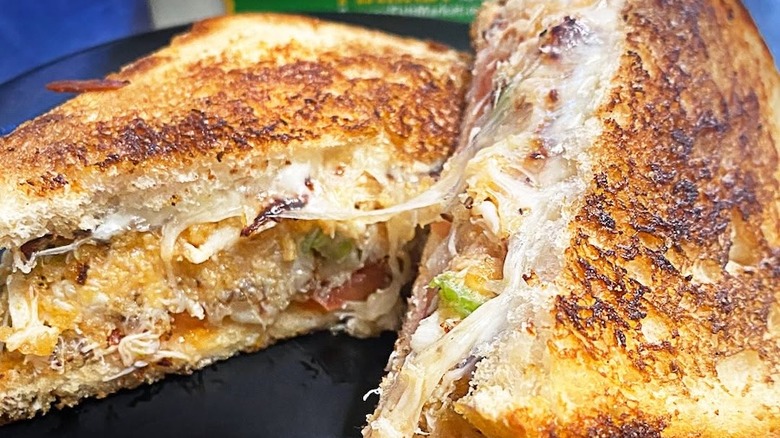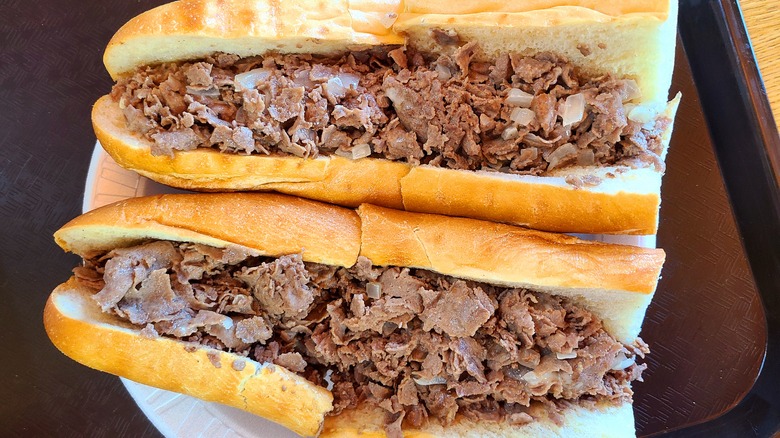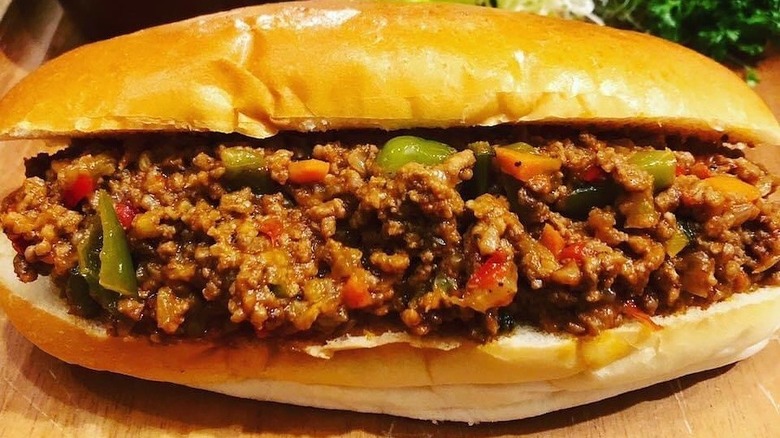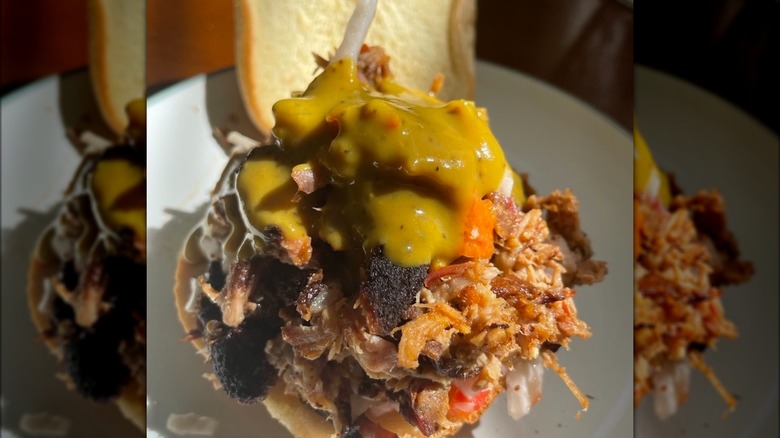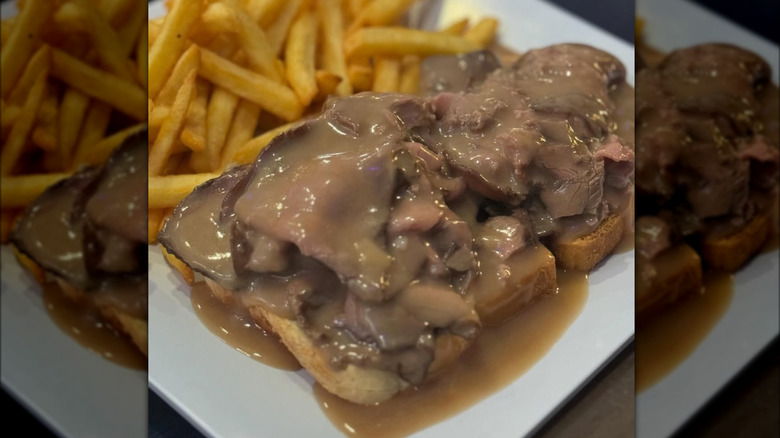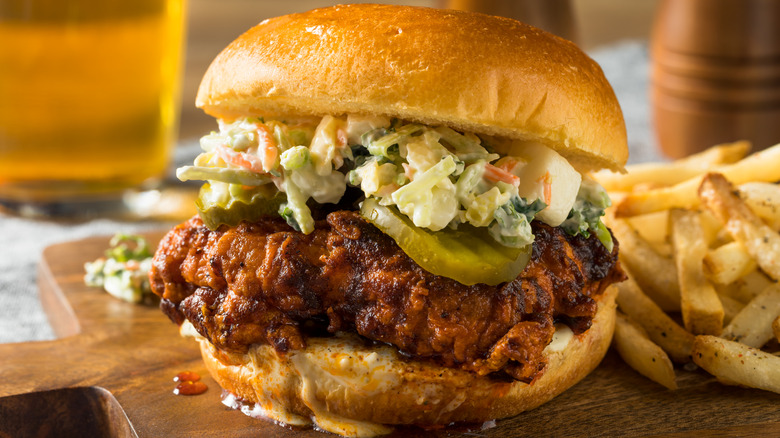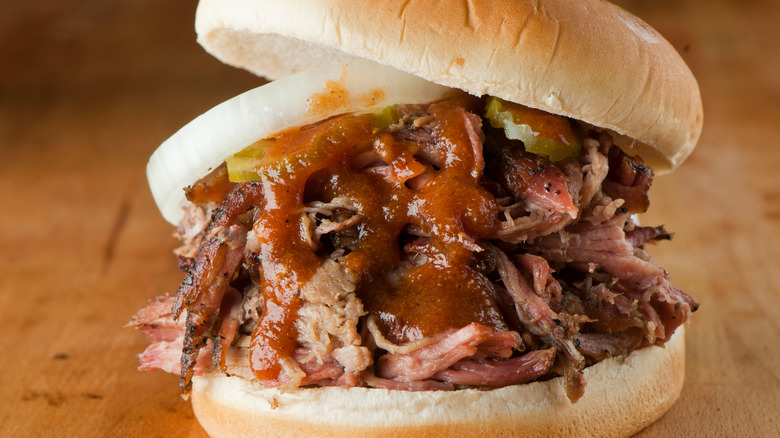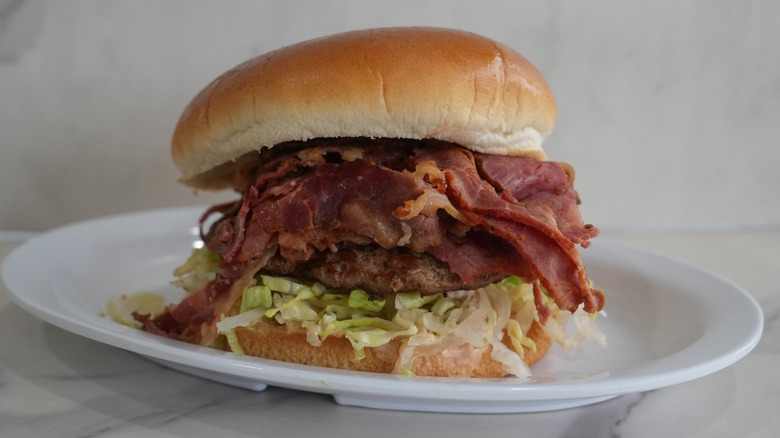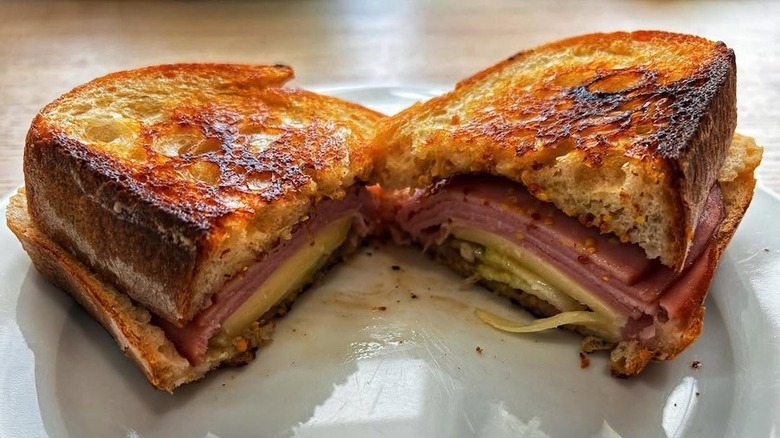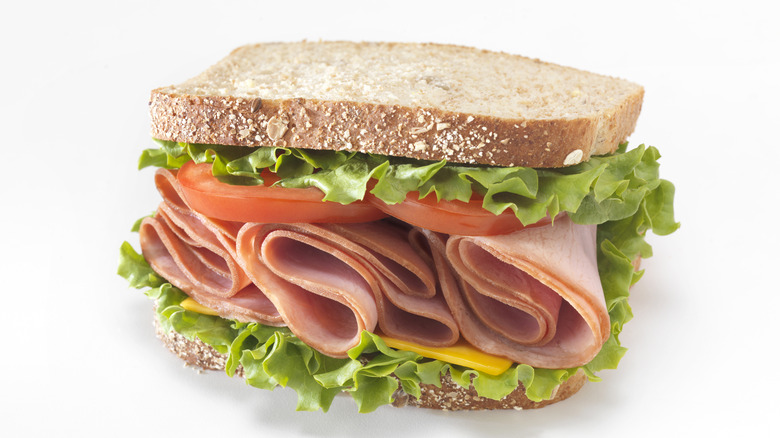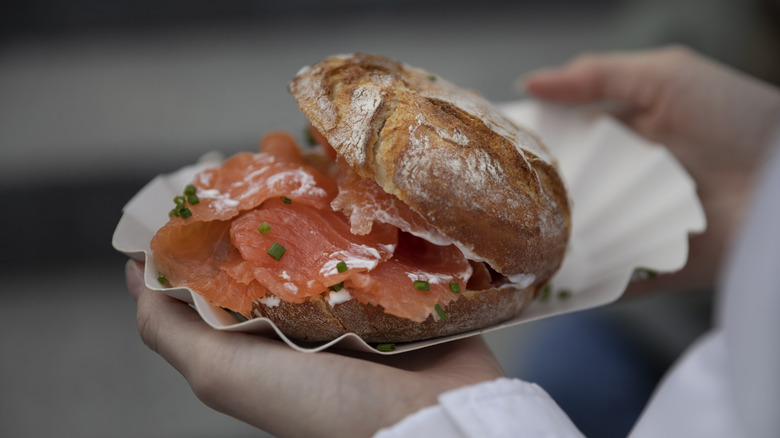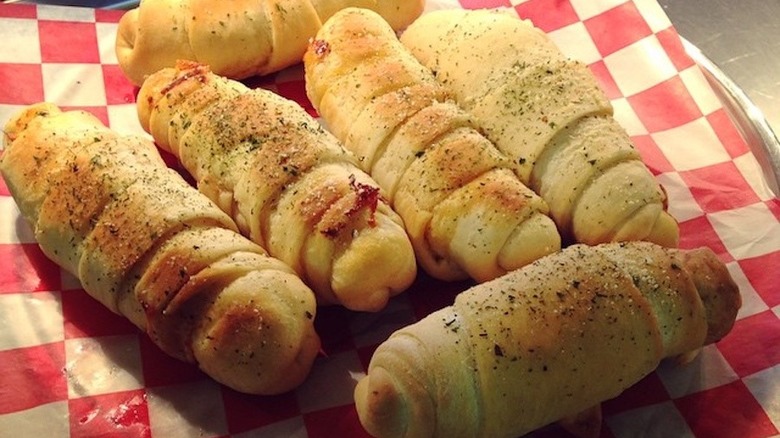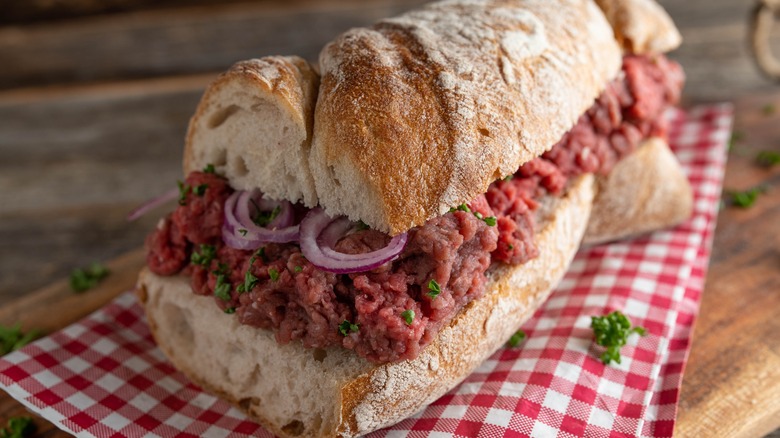The Signature Sandwich Of Every State
Humble and elegant, simple and elaborate, the sandwich is a quintessentially American contribution to food history. Although its creation may be attributed to Britain's Earl of Sandwich, the U.S. has more than made the sandwich its own, and a gift to the world. But what even is a sandwich? We're choosing to define it as anything between two pieces of bread, or a bread-like flat carbohydrate folded over to approximate two pieces of bread.
After that, brilliant professionals and amateurs have taken those simple parameters and gotten extremely creative, occupying the space between bread with all manner of things. A sandwich doesn't need all that much meat, but it's also a place where cheeses, sauces, condiments, and vegetables can come together in both logical pairings and bizarre and delicious sandwich combos alike.
The sandwich is so American, utilitarian, and open for interpretation that dozens of sandwich styles have been created, popularized, and perfected stateside. Since it's such a big country with a wide array of ingredients available to specific regions, with specific tastes, every state in the nation has a sandwich that it can claim as its own. Here are the stories of 50 sandwiches, one signature 'wich for every one of the United States' states.
Alabama - Pulled chicken with white sauce
Alabama white sauce is what makes the state's barbecue culture so distinctive. Made with mayonnaise, vinegar, apple juice, and horseradish the same way Big Bob Gibson did in Decatur in 1925, it pairs excellently with Alabama's signature barbecue protein: smoked chicken. As a sandwich, pulled chicken drenched in white sauce is an Alabama standard.
Alaska - Halibut sandwiches
More than 95% of all halibut caught in the U.S. comes from the waters around Alaska, so it's an important product and food source in the northernmost state. Sandwiches made with freshly caught halibut are commonplace in various permutations and presentations, grilled, fried, and blackened among them.
Arizona - Navajo tacos
This mashup of a Mexican staple with a traditional food of the Navajo people, who historically resided in the American Southwest, was named the State Dish of Arizona in 1995. Made with what's also known as Indian fry bread, it was developed when the Navajo were held in camps by white settlers in the 1860s and given rations of lard, flour, salt, and baking powder. Adding taco-worthy fillings followed decades later.
Arkansas - Fried bologna sandwich
Bologna is generally so cheap that it's an affordable meat source across economic groups, and it's also historically popular in Arkansas. For decades, bologna made by Petit Jean Meats and other long-operating butchers has served as the basis for the fried bologna sandwich. It fries up quickly and easily in a pan, and when placed between two pieces of bread, it is a common Arkansas breakfast on the go.
California - French dip
The French dip consists of thin-cut roast beef and often cheese alongside a cup of salty and savory pan drippings for dunking the sandwich. It gets its name from the employment of a French roll, not its place of origin, which is somewhere in Los Angeles. Cole's claims to have invented the sandwich in 1908, while L.A. eatery Philippes says it did so in 1918.
Colorado - Denver sandwich
The Denver omelet is probably the most famous fixed-ingredient omelet. That dish is a variation of the older Denver sandwich. Pretty much just the well-known omelet between two slices of toasted white bread, the Denver sandwich was most popular in the mid-20th century and consisted of eggs, green peppers, onions, cheese, and ham.
Connecticut - Grinder
A sandwich of stacked Italian-style cold cuts and cheese on a long roll has lots of names, such as hoagie, submarine, and grinder. The latter is the one by which it was first known when it was popularized in the 1920s at Nardelli's Grinder Shoppe in Waterbury, Connecticut, because the bread was so tough it took a grinding motion of the teeth to chew through it.
Delaware - The Bobbie
An original and now signature menu item at the first Capriotti's sandwich shop in Wilmington was named after Bobbie Capriotti, the founders' aunt. On the day after Thanksgiving each year, she'd make big sandwiches piled high with leftovers: roasted turkey, stuffing, and cranberry sauce (plus mayonnaise) on a roll. The Bobbie has been sold at all Capriotti's locations since 1976.
Florida - Cubano
Two Florida cities, Tampa and Miami, claim to be the birthplace of the Cubano, inspired by the mixto, a mixed meat sandwich likely brought to the U.S. by Cuban immigrants. By the mid-20th century, after a major Cuban community had developed in Florida, the Cubano sandwich construction had become standardized: pork, ham, Swiss cheese, mustard, and pickles, all on Cuban-style bread. It's often grilled or pressed, too.
Georgia - Pimento cheese
The demand for pimentos — sweet Spanish peppers — for use in dips and spreads was so significant in the early 20th century that industrial cultivation and canning operations developed in Griffin, Georgia. After World War II, pimento cheese recipes started to disappear from domestic-themed magazines, but not in Georgia, where sandwiches made from homemade or canned pimento cheese spread (peppers, mayo, and shredded cheese) remain a regular part of life.
Hawaii - Kalua pork
In Hawaii, there's an ancient cooking process wherein an entire pig is slow-cooked and smoked in an imu, or underground chamber. That results in juicy, flavorful slow-roasted pork, or kalua, seasoned with salt, various herbs, and banana leaves. In modern Hawaii, and in some of America's fastest growing restaurants, kalua pork is served in many ways, including as a sandwich filling paired with sauce and other condiments.
Idaho - Peanut butter and huckleberry jam
Numerous varieties of the huckleberry grow wild and are cultivated in Idaho, where it's the official state fruit. So much of the crop is made into jam that it's been incorporated into a local take on a classic American favorite: the peanut butter and jelly sandwich, but with huckleberry jam — often homemade — adding sweetness and tanginess to elevate the dish.
Illinois - Italian beef
Italian immigrants newly arrived in Chicago in the early 1900s stretched their wedding budgets by serving their guests from an inexpensive beef cut sliced thin. Sandwich vendor Anthony Ferrari picked up the practice, marinating and slicing his beef. Those Italian beef sandwiches — served on Italian rolls and topped with hot giardiniera peppers — sold very well, as did the ones by numerous imitators and competitors.
Indiana - Pork tenderloin sandwich
As one of the more robust pork producing states, Indiana knows what to do with all the parts of a pig. That's represented in the food culture by the state's favorite pork tenderloin sandwich. The cut of meat gets hammered until it's very thin, then it's breaded, deep-fried, and placed on a bun, which is inevitably too small to hold that giant cutlet.
Iowa - Loose meat
Also appearing on menus as a tavern or canteen sandwich, a loose meat sandwich is a sauceless Sloppy Joe or an unpattied hamburger. Basically, it's a pile of cooked and seasoned ground beef loaded onto a bun and adorned with mustard and pickles. Popular as a food truck and lunch counter offering, Iowa's biggest seller is Maid-Rite, a loose meat sandwich shop with over a dozen locations in the state.
Kansas - Burnt ends sandwich
Burnt ends are a staple of the Kansas City, Kansas, style of barbecue. Those caramelized, smoky, meaty, fatty chunks of beef brisket are the main ingredient in many Kansas City barbecue joints' sandwiches, seasoned and topped with rubs, barbecue sauce, and maybe some slaw, before everything is shoved into a bun.
Kentucky - Hot Brown
In the go-go 1920s, revelers would head to Louisville's Brown Hotel for late-night dances and then retire to the restaurant. Chef Fred Schmidt created a special dish for the events: a turkey sandwich served hot and open-faced, topped with bacon, tomatoes, cheese, and creamy Mornay sauce. Before long, the Hot Brown became a statewide classic.
Louisiana - Muffuletta
Created in New Orleans in 1906 by Sicilian emigrant Lupo Salvadore at his Central Grocery, the muffuletta is Louisiana's twist on the submarine sandwich. It's familiar due to the stacks of thinly cut meats and cheeses, but it's different due to the inclusion of a tasty paste made from finely minced olives, and the way it's traditionally served on a sesame seed-laden roll.
Maine - Lobster roll
Most of the lobster sold in the United States comes from Maine. Using it in a sandwich in such a way originated in Connecticut, but seafood restaurants throughout the most northeastern of states have since developed similar recipes for the lobster roll, in which big chunks of lobster are mixed up with a mayonnaise-based dressing and loaded into a buttery split bun.
Maryland - Crab cake sandwich
Hundreds of millions of blue crabs are caught in Maryland's Chesapeake Bay each year, and so lump crab meat figures into the local diet. Crab cakes are big, and those traditionally Old Bay-seasoned patties of shellfish and breadcrumbs easily fit into a bun or a roll, along with some aioli or mayonnaise.
Massachusetts - Fluffernutter
The Fluffernutter is a sticky New England delicacy. Its name is a playful portmanteau — the "fluffer" meaning the name-brand marshmallow creme Marshmallow Fluff and the "nutter" referring to peanut butter, the only two ingredients in this white bread sandwich. The creme was a locally popular product, and it was eventually mass-produced by Durkee Mower after the demand for homemade fluffernutters spread via World War I-era newspaper recipes.
Michigan - Michigan pasties
In the Cornwall region of England, miners historically ate meat and vegetable hand pies for lunch. In the 19th century, Cornish emigrants came to Michigan's Upper Peninsula to work the mines, and they kept the meat pie tradition alive. Therein, they became known as beef and root vegetable-heavy Michigan pasties, which are still sold at countless diners and roadside stands in the area.
Minnesota - Fried walleye
April to July marks the bountiful walleye spawning and fishing season in the Great Lakes area. Many of the perch species caught wind up fileted, breaded, fried, and placed on a soft bun to make a walleye sandwich, which is traditionally dressed with lettuce, tomato, and a little pickle juice.
Mississippi - Catfish po' boy
Po' boys, cheap sandwiches given away for free to striking laborers in New Orleans in the 1920s, made their way to nearby Mississippi, which farms so much catfish that it's known as the Catfish Capital of the World. A plentiful and inexpensive filling, the fish is breaded in cornmeal and then fried, making up the bulk of Mississippi's po' boy.
Missouri - The St. Paul
The St. Paul sandwich was created in the 1940s by a Chinese-American cook looking to appeal to American tastes. Between two pieces of white bread slathered in mayonnaise, he placed an egg foo young patty, made with flour, onions, bean sprouts, and eggs. Named after the cook's hometown of St. Paul, Minnesota, the sandwich became a local institution; it's sold all over St. Louis, often with additional meats added to the patty.
Montana - Pork chop sandwich
In 1924, Swedish emigrant John Burklund settled in Butte, Montana, and operated a wagon to sell pork chop sandwiches to the many local copper mine workers. Within a few years, there were Pork Chop John's shops all over Montana selling the sandwiches. The boneless pork chops are pounded, breaded, and deep-fried, then tucked into a bun.
Nebraska - Cheese Frenchee
In the 1950s, the popular Lincoln restaurant King's Food Host began serving its signature dish, the Cheese Frenchee. Likely named for its vague similarity to the Croque Monsieur from France (it's also known as the Cheese Frenchie), it's a grilled cheese sandwich that's been dipped in egg and battered with crushed crackers or Corn Flakes, then deep-fried.
Nevada - Patty melt
The patty melt is the marriage of a grilled cheese sandwich and a hamburger, consisting of a ground beef patty topped with Swiss cheese and caramelized onions, then placed between two slices of bread. The whole thing is grilled, and it's been on the menu at Nevada's many small diners and casino-adjacent spots since it was created in the early 1930s at Du-par's at the Suncoast Hotel in Las Vegas.
New Hampshire - Steak and cheese sub
A steak and cheese sub sandwich ordered in New Hampshire is different from a Philly cheesesteak. While the latter is categorically made with shaved beef and processed cheese, a steak and cheese could be made with most any variety of steak, served whole or chunked, and topped with real, melted cheese, often provolone. In New Hampshire, diners are much more likely to find additions like peppers and mushrooms.
New Jersey - Pork roll
This typical breakfast sandwich for many people across New Jersey is also known as a Jersey breakfast or a pork roll. Stuffed into a bread roll of some kind are eggs, cheese, and one or two thick slices of pork roll, which is the colloquial name for Taylor ham. It can be found in restaurants and convenience stores throughout the state.
New Mexico - Green chile cheeseburger
The chile is an official vegetable of New Mexico, and both red and green varieties persistently appear in local dishes, particularly the green chile cheeseburger. The Owl Bar outside Los Alamos claims it invented the dish when serving the Manhattan Project scientists who were developing the nuclear bomb during World War II. The cook ran out of plates to serve the chiles as a side dish for a burger, so he put them right on the meat instead.
New York - Pastrami on rye
New York City's Katz's Deli sells a whopping amount of pastrami each week, much of it starring in very tall pastrami on rye sandwiches. The most famous sandwich in New York's thriving deli culture was introduced by European immigrants more than a century ago, and it pairs a densely flavored bread with cured, salty, tangy beef.
North Carolina - Flour burger
At Snappy Lunch in Mount Airy, North Carolina, the town that inspired Mayberry in "The Andy Griffith Show," the breaded hamburger or flour burger remains on the menu, a relic of the Great Depression. To stretch beef, home and diner cooks added breadcrumbs, flour, or crumbled biscuits to burger patties. They're also called slugburgers because back in the 1930s, they cost a nickel, or a slug.
North Dakota - Fleischkuechle
Black Sea Germans from Russia settled in North Dakota 150 years ago, bringing with them a sandwich called fleischkuechle, which translates to "meat bread." It's a fully enclosed pocket sandwich of deep-fried dough containing seasoned ground beef and minced onions. Rarely is it homemade anymore, but stores and restaurants throughout North Dakota sell ready-to-eat versions.
Ohio - Polish boy
Ohio produces a great deal of kielbasa sausage, and the smoked, fatty, and meaty link is the basis of the Cleveland-created Polish Boy. The Polish sausage is placed into a long roll, then topped with a small mountain of fries and coleslaw, before the whole thing gets drenched in barbecue sauce.
Oklahoma - Fried onion burger
During the Great Depression, two burger joints in El Reno got the idea to bulk up expensive ground beef patties with piles of paper-thin onion slices. The burger patties were smashed into the onions as they grilled to create a thin, wide shape, making for a tangy, spicy, beefy combo. El Reno sits at the junction of two highways, and the Oklahoma fried onion burger, or smashburger, quickly spread statewide.
Oregon - Dungeness crab melt
The Dungeness crab industry is vital to Oregon's coastal economy, and so is tourism. Many of the restaurants in the state's numerous beach towns offer their version of a crab melt. The sweet, meaty crustacean flesh, mayonnaise, and cheese (such as Oregon-made sharp cheddar) go between two pieces of bread, and it's all grilled up together.
Pennsylvania - Philly cheesesteak
An iconic American sandwich with a simple build, the Philly cheesesteak is a flaky and crunchy bread roll containing mounds of shaved and sauteed beef ribeye with onions, then covered in melty cheese (commonly American or Cheez Whiz, and sometimes even provolone). It's been a Philadelphia hallmark since hot dog vendor Pat Olivieri started selling beef sandwiches on a lark one day in 1930.
Rhode Island - Dynamite or torpedo
In the town of its origin, the sloppy joe-like sandwich is called a dynamite, but outside of Woonsocket, it's a torpedo. The name refers to the style of long roll used, which can withstand the load of ground beef that's been cooked in a tomato-garlic sauce along with chopped onions and peppers. A batch can feed a crowd, making these sandwiches a popular choice at large events.
South Carolina - Carolina pulled pork
South Carolina claims to be the birthplace of American barbecue, and pork is the most commonly used meat locally. Slow-cooked pulled pork that's been heavily treated with the sharp and zesty mustard-based Carolina gold barbecue sauce and a helping of coleslaw makes up the quintessential South Carolina sandwich.
South Dakota - Hot roast beef
How does one improve on a roast beef sandwich? Do like they do in South Dakota and serve the whole thing — chunks or shreds of slow-cooked beef on white bread — covered in mashed potatoes and brown gravy, and make it piping hot. It's such a South Dakota staple that the much heralded tourist trap of Wall Drug offers one at its restaurant.
Tennessee - Nashville hot chicken
Nashville hot chicken was concocted by Prince's Hot Chicken, back in the 1930s, supposedly after cook Thornton Prince was pranked with a plethora of spices and flavorings added to his fried chicken. He fine-tuned the recipe into a very hot and very sweet melange, and the internationally famous, Tennessee-originated seasoning now goes on fried boneless chicken breasts to make sandwiches, served with some customary pickle slices.
Texas - Chopped brisket
In the storied history of barbecue in cattle ranch-laden Texas, the meat of choice is beef, and the signature cut is a brisket, slowly smoked and cooked to make it tender and juicy. Slices or chopped chunks are often served as a sandwich — they go on bread or in a bun with some barbecue sauce, and that's pretty much all.
Utah - Pastrami burger
Crown Burgers proliferated in Salt Lake City in the 1970s, after its Greek immigrant owners were inspired by a pastrami-topped cheeseburger sold at a relative's restaurant in California. Now a standard Utah menu item, the pastrami burger is a regular cheeseburger with all the fixings, plus as much pastrami as the bun can hold.
Vermont - The Vermonter
Vermont is famous for its extra-sharp cheddar cheese, so that's certainly going to be a focal point of the state's eponymous sandwich. A Vermonter pairs that tangy cheese with other local ingredients, such as slices of apple and a touch of maple syrup for sweetness, as well as turkey or ham and brown mustard.
Virginia - Virginia ham
Smithfield, Virginia, is one of the world's most prolific ham-producing areas, and it makes Virginia-style ham. That means the prized pork is cured and smoked according to methods that European settlers learned from indigenous people in the Jamestown colony nearby. Virginia-raised and Virginia-treated ham is thus the protein of choice for ham sandwiches made in Virginia, whether the meat is served cold or fried.
Washington - Smoked salmon
Salmon is so important to the history, economy, and culture of Washington that in 1987, state lawmakers would only consider smoked salmon entries when deciding on an official state sandwich. Out of the 100-plus sandwiches considered, the winner was a simple preparation of smoked salmon on whole wheat bread.
West Virginia - Pepperoni rolls
The pepperoni roll, an enclosed, pocket or calzone-style sandwich, is the state food of West Virginia. Country-style bread dough is rolled out and then stuffed with pepperoni slices or whole sticks. The rolls have been sold pre-made and pre-baked in West Virginia since 1927; before that, they were prepared for lunch for the Italian immigrants who came to the state for jobs in the coal mining industry.
Wisconsin - Cannibal sandwich
Making cannibal sandwiches has been a Christmas season tradition in the Milwaukee area for decades. Likely inspired by the northern European settlers who helped colonize Wisconsin, those who dare buy raw, high-grade ground beef season and spice it, and match it with a hefty amount of raw onions to create a sandwich deserving of such a name.
Wyoming - Trout sandwich
Wyoming is such a hotbed for cutthroat trout that it's a fishing destination spot for tourists. Residents have long incorporated the favored local fish, particularly as a sandwich protein. Different kinds of trout can be found between bread in different ways around the state, most often filleted, breaded, and fried until crispy.
